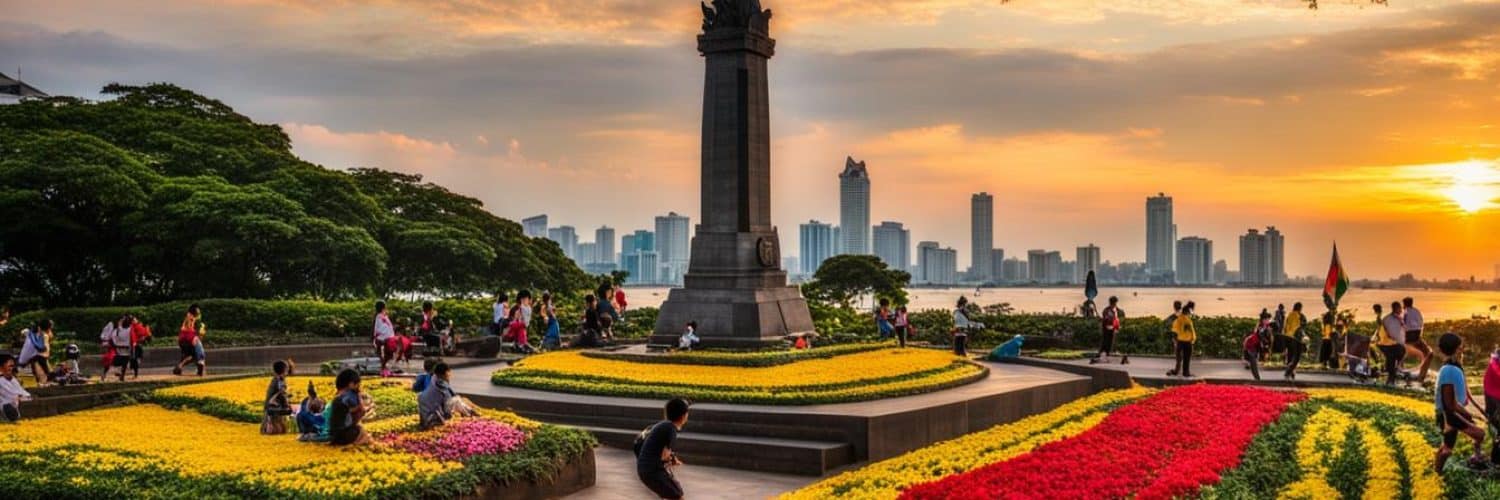Rizal Park, also known as Luneta Park, is a must-visit destination in Manila for history enthusiasts and tourists looking to immerse themselves in the rich cultural heritage of the Philippines. Located in Ermita, Manila, this expansive urban park offers a fascinating glimpse into the country’s past with its historical landmarks and captivating landscapes.
Spanning over 58 hectares, Rizal Park stands as one of the largest urban parks in the Philippines. It holds great historical significance, as it was the site of the execution of the Filipino patriot José Rizal and the declaration of the Philippines’ independence from the United States. With its monuments, gardens, and picturesque views of Manila Bay, Rizal Park is a treasure trove of cultural heritage waiting to be explored.
Key Takeaways:
- Rizal Park, also known as Luneta Park, is a historic urban park located in Ermita, Manila.
- Rizal Park is home to several historical landmarks, including the iconic Rizal Monument.
- The park offers serene gardens, captivating landscapes, and stunning views of Manila Bay.
- Fort Santiago, located within Rizal Park, is a majestic fortress that holds significant historical value.
- Explore the Manila Baywalk to experience the city’s maritime history and enjoy breathtaking sunsets.
A Glance into History
Discover the rich historical origins of Rizal Park, formerly known as Bagumbayan, which has witnessed the unfolding of significant events throughout its existence. Situated strategically near the walled city of Intramuros, this small town transformed over time, eventually becoming an integral part of Manila’s cultural landscape.
During the British invasion, Bagumbayan was cleared, and its location was repurposed as a moat-surrounded outwork of the walled city. However, in 1820, the completion of the Paseo de Luneta marked the foundation of what would later become Rizal Park. From that point onward, the park served as a witness to various historical milestones that shaped the nation.
“With each step taken within the park’s boundaries, visitors can feel the echoes of the past resounding in every inch of this historically significant site.”
Public executions took place within the park’s premises, highlighting the tumultuous nature of Philippine history. Additionally, it was in Rizal Park, then Bagumbayan, that the Filipino patriot José Rizal faced his execution, solidifying his legacy as a national hero and martyr.
Today, as visitors explore the stunning landscapes and iconic features of Rizal Park, they are reminded of the park’s historical foundations and its continued significance as a testament to the nation’s resilience and spirit.
Historical Events at Rizal Park
| Period | Significant Events |
|---|---|
| Spanish Colonial Period | Establishment of Bagumbayan |
| British Invasion | Transformation into a moat-surrounded outwork |
| 1820 | Completion of Paseo de Luneta |
| Various Periods | Public executions |
| 1896 | Execution of José Rizal |
A Symbolic Focal Point
The Rizal Monument at Rizal Park in Manila is an iconic symbol of honor and tribute to José Rizal, the national hero of the Philippines. Erected in commemoration of his significant contributions to Philippine history, the monument stands tall as a reminder of his enduring legacy. The Rizal Monument, inaugurated in 1913, houses the remains of Rizal and serves as a place of reverence and reflection.
“The monument is a testament to the courage, intellect, and patriotism of our national hero, José Rizal.”
Visitors to Rizal Park can pay their respects to Rizal and learn more about his remarkable life and achievements. The monument’s grandeur and symbolism make it a focal point in the park, attracting tourists and locals alike. As visitors stand before the monument, they are reminded of Rizal’s unwavering dedication to the Filipino people and his fight for freedom and independence.
Key Features of the Rizal Monument
The Rizal Monument at Rizal Park stands as a prominent landmark in Manila, capturing the attention of those who visit. Here are some key features of this monumental tribute:
- A massive granite obelisk rising 46 meters into the sky
- A base adorned with intricate sculptures depicting scenes from Rizal’s life
- A bronze statue of Rizal located at the top of the obelisk
- An underground chamber where Rizal’s remains are interred
The statue of Rizal shows him holding a book, symbolizing his wisdom and intellect. It serves as a constant reminder of the power of knowledge and education in fostering change. Surrounding the monument, visitors can find beautifully landscaped gardens, providing a serene atmosphere for reflection and contemplation.
Impact on Filipino Identity
The Rizal Monument plays a significant role in shaping the Filipino identity and national pride. It serves as a tangible representation of the values and ideals that Rizal stood for, inspiring generations of Filipinos to strive for excellence, fight for justice, and contribute to the progress of the nation.
| Key Messages | Impacts |
|---|---|
| Preservation of Heritage | Reminds Filipinos of their rich cultural and historical heritage |
| National Unity | Serves as a unifying symbol for all Filipinos, regardless of their background or beliefs |
| Inspiration and Aspiration | Motivates individuals to embrace Rizal’s ideals and strive for personal and societal progress |
The Rizal Monument stands as a testament to the enduring legacy of a truly remarkable individual and the indomitable spirit of the Philippine people. It is a significant destination within Rizal Park, capturing the essence of Philippine history, culture, and patriotism.
Captivating Landscapes
Rizal Park in Manila is renowned for its stunning landscapes and captivating views. With its meticulously manicured gardens and scenic vistas, the park offers a tranquil escape from the hustle and bustle of the city. One of the highlights of Rizal Park is the Japanese Garden, where visitors can immerse themselves in the serene ambiance and admire the exquisite stone lanterns that adorn the pathways. Another enchanting garden within the park is the Noli Me Tangere Garden, which provides a charming setting for leisurely strolls and quiet contemplation.
As visitors explore Rizal Park, they will be treated to picturesque views of Manila Bay. The glistening waters of Manila Bay, combined with the lush greenery of the park, create a breathtaking backdrop that is sure to leave a lasting impression. Whether it’s the vibrant colors of a sunrise or the romantic glow of a sunset, the panoramic views of Manila Bay offer a sense of serenity and beauty.
Experience the enchanting gardens and scenic splendor of Rizal Park, where nature’s beauty intertwines with the rich history and cultural heritage of Manila.
“The beauty of Rizal Park lies not only in its historical significance but also in the captivating landscapes that make it a true urban oasis.” – Manila Travel Guide
Fort Santiago and the Rizal Shrine
Fort Santiago, located within Rizal Park in Manila, is a majestic fortress that holds significant historical value. It is here that José Rizal, the national hero of the Philippines, was imprisoned before his execution. Visitors can immerse themselves in history as they explore the fortress and wander through its dimly lit cells.
Fort Santiago stands as a solemn testament to the life and sacrifice of José Rizal, offering a glimpse into the events that led to his martyrdom. As visitors delve into the fortress’s intricate architecture, they can reflect upon the courage and resilience that defined Rizal’s character.
“The life of José Rizal serves as an inspiration to all Filipinos, and Fort Santiago stands as a symbol of his unwavering dedication to the pursuit of freedom and justice.”
Within the walls of Fort Santiago lies the Rizal Shrine, a museum dedicated to preserving the memory of José Rizal and his significant contributions to Philippine history. The museum houses a remarkable collection of artifacts, exhibits, and memorabilia, each telling a story of Rizal’s life and achievements.
Rizal Shrine Highlights
The Rizal Shrine offers a comprehensive and immersive experience for visitors. Some of the highlights include:
| Exhibits | Description |
|---|---|
| Personal Belongings | An exhibition of Rizal’s personal items, including clothing, documents, and manuscripts. |
| Mural Paintings | A visual representation of key events and moments in Rizal’s life, depicted through stunning mural paintings. |
| Photographs and Portraits | A collection of photographs and portraits capturing the essence of Rizal’s life and the people who played significant roles in his journey. |
| Philippine Revolution | An exhibition highlighting the Philippine Revolution and its impact on the country’s fight for independence. |
Visiting Fort Santiago and the Rizal Shrine is not only an educational experience but also a chance to pay tribute to an extraordinary individual who shaped the course of Philippine history. It is a journey of remembrance and appreciation for the invaluable legacy left behind by José Rizal.
Manila Baywalk and Maritime History
The Manila Baywalk, located along Roxas Boulevard, offers a unique blend of natural beauty and maritime history. Visitors can take a leisurely stroll along the baywalk, enjoying the scenic views of Manila Bay and the breathtaking sunsets. The baywalk also serves as a reminder of the nautical tales of valor that shaped the country’s history. It is a perfect spot to immerse oneself in the charm of Manila and appreciate its connection to the sea.
Explore Manila Baywalk
The Manila Baywalk is a stunning promenade that stretches along the scenic Manila Bay. With its picturesque views and vibrant atmosphere, it has become a popular destination for leisurely walks, romantic dates, and family outings. The baywalk is lined with a variety of restaurants, cafes, and bars, where visitors can indulge in delicious cuisine while enjoying the sea breeze.
Maritime History
The baywalk’s location holds significant maritime history for Manila. As a prominent seaport, Manila has played a vital role in the Philippines’ maritime heritage. From the days of Spanish galleons to the modern shipping industry, Manila Bay has witnessed countless maritime adventures and trade journeys. Exploring the baywalk allows visitors to appreciate this rich maritime history and the city’s strong connection to the sea.
“The sea, once it casts its spell, holds one in its net of wonder forever.” – Jacques Yves Cousteau
Famous Landmarks along Manila Baywalk
| Landmark | Description |
|---|---|
| Roxas Boulevard | A major boulevard that runs alongside Manila Bay, offering stunning waterfront views and direct access to the baywalk. |
| Manila Yacht Club | A prestigious yacht club that has been a hub for sailing enthusiasts and yacht lovers since 1927. |
| Cultural Center of the Philippines | An iconic cultural complex that showcases Filipino arts and culture through various performances, exhibits, and events. |
| Mall of Asia | One of the largest shopping malls in the world, offering a wide range of retail stores, dining options, and entertainment facilities. |
Whether you’re a history enthusiast, nature lover, or simply seeking a relaxing experience, Manila Baywalk is a destination that has something for everyone. It provides a unique glimpse into Manila’s vibrant culture, maritime past, and breathtaking natural beauty.
Paco Park – A Tranquil Respite
Paco Park, located in Manila, is a historic park that offers a peaceful respite from the bustling city. Initially, it served as a burial ground during the Spanish colonial period, but it has since been transformed into a national park.
Today, Paco Park serves as a serene sanctuary where visitors can escape the city noise and immerse themselves in its tranquil ambiance. The park features a charming chapel and beautiful gardens, making it an ideal spot for relaxation and reflection.
Surrounded by lush greenery, Paco Park provides a calming atmosphere that allows visitors to unwind and connect with nature. The park’s well-manicured gardens offer a picturesque setting, perfect for leisurely walks or quiet moments of contemplation.
“Paco Park is a hidden gem in the heart of Manila. Its serene environment and rich history make it a must-visit destination for those seeking a tranquil escape,” says Maria Rodriguez, a local resident.
Aside from its natural beauty, Paco Park also holds historical significance. Its chapel, known as the St. Pancratius Chapel, has been a venue for weddings and concerts. The circular shape of the chapel and its remarkable acoustics make it a popular choice for musical performances.
“Paco Park’s chapel provides a unique setting for weddings. It exudes a romantic and intimate atmosphere that adds a touch of magic to special occasions,”
shares Anna Santos, a wedding planner.
Whether you’re seeking a peaceful escape, a scenic backdrop for photography, or a venue for special events, Paco Park offers a delightful experience that combines history, nature, and tranquility.
Arroceros Forest Park – A Green Sanctuary
Arroceros Forest Park, situated at the heart of Manila, is a tranquil green oasis that serves as an essential sanctuary amidst urban development, offering a refreshing escape into nature. This hidden gem provides a breath of fresh air and an opportunity to connect with the vibrant greenery that surrounds it.
The park boasts a rich diversity of local plant species, creating a lush and vibrant environment for visitors to explore. As you wander through the park’s winding trails, you’ll encounter a myriad of flora, contributing to the park’s status as a true green sanctuary in the bustling city.
Arroceros Forest Park has a long and fascinating history, having served various purposes throughout the years. From its early days as a tobacco manufacturing site during the Spanish colonial period to its role as military housing in the 20th century, the park has stood witness to the transformation of Manila.
Today, Arroceros Forest Park not only provides a serene space for relaxation and reflection but also serves as an educational venue. Visitors can learn about the park’s historical significance through informative displays and guided tours, gaining a deeper understanding of Manila’s past.
Whether you are seeking solitude amidst nature, a picturesque backdrop for a leisurely stroll, or an opportunity to delve into Manila’s history, Arroceros Forest Park promises to be a green haven that offers a respite from the bustling city streets.
Conclusion
Rizal Park, located in Manila, is a testament to the rich history and cultural heritage of the Philippines. This iconic park is home to historic landmarks that embody the spirit of the country. At the heart of the park stands the magnificent Rizal Monument, honoring the national hero José Rizal and his significant contributions to Philippine history.
As you explore Rizal Park, you will be captivated by the serene gardens and breathtaking views of Manila. The Japanese Garden and Noli Me Tangere Garden offer peaceful sanctuaries, allowing you to immerse yourself in the beauty of nature. And when you gaze upon the picturesque Manila Bay, you will witness the deep connection between the city and its maritime history.
Whether you are a tourist discovering Manila for the first time or a local seeking to reconnect with your country’s heritage, Rizal Park is a must-visit destination. It is a place where you can stroll through history, pay your respects at the Rizal Monument, and appreciate the cultural richness that defines the Philippines. Don’t miss the opportunity to experience Rizal Park and embrace the vibrant essence of Manila.
FAQ
Where is Rizal Park located?
Rizal Park, also known as Luneta Park, is located in Ermita, Manila.
What is the significance of Rizal Park?
Rizal Park holds great historical significance as it was the site of the execution of Filipino patriot José Rizal and the declaration of Philippine independence from the United States.
How big is Rizal Park?
Rizal Park covers an area of 58 hectares, making it one of the largest urban parks in the Philippines.
What can I see at Rizal Park?
At Rizal Park, you can see the iconic Rizal Monument, manicured gardens, and enjoy picturesque views of Manila Bay.
What is Fort Santiago?
Fort Santiago is a historic fortress located within Rizal Park. It was the place where José Rizal, the national hero, was imprisoned before his execution.
What can I expect to see at Fort Santiago?
At Fort Santiago, you can explore the fortress, wander through its dimly lit cells, and visit the Rizal Shrine, a museum dedicated to preserving Rizal’s memory and showcasing artifacts and exhibits related to his life and achievements.
What is the Manila Baywalk?
The Manila Baywalk is a scenic promenade along Roxas Boulevard that offers stunning views of Manila Bay and serves as a reminder of the country’s maritime history.
What is Paco Park?
Paco Park is a historic park located in Manila that was originally a burial ground during the Spanish colonial period. It now offers a tranquil sanctuary and features a chapel and beautiful gardens.
What is Arroceros Forest Park?
Arroceros Forest Park is a green oasis nestled in the heart of Manila. It serves as a vital sanctuary against urban development and offers fresh air, nature, and a rich historical background.
Why should I visit Rizal Park?
Rizal Park offers a glimpse into the Philippines’ rich history, stunning landscapes, and cultural heritage. It is a must-visit destination that encapsulates the spirit and essence of the country.


















Add comment